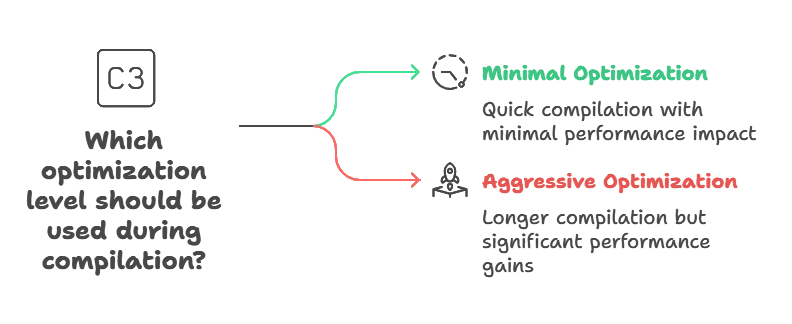Compiler Optimization Flags
Compiler optimization flags in Go are powerful tools that allow developers to fine-tune the performance and behavior of the Go compiler. These flags control various aspects of the compilation process, influencing how the compiler generates machine code from high-level Go source code. This chapter explores compiler optimization flags from basic concepts to advanced techniques, empowering developers to optimize their Go code for speed, size, and resource usage.
Understanding Compiler Optimization Basics
Basic Concepts
Compiler optimization involves transforming source code to produce optimized machine code. Optimization flags control the level of optimization applied during compilation, balancing factors such as execution speed, binary size, and memory usage.
Levels of Optimization
Go provides several optimization levels, from minimal optimization (level 0) to aggressive optimization (level 3). Higher optimization levels may result in longer compilation times but can yield significant performance improvements.

Exploring Common Optimization Flags
O flag: Control Optimization Level
The -O flag allows developers to specify the optimization level during compilation. It accepts arguments from 0 to 3, with 0 disabling optimization and higher levels enabling increasingly aggressive optimizations.
go build -gcflags="-O=2" main.go
This command compiles main.go with optimization level 2.
-l flag: Disable Inlining
Inlining is a compiler optimization where the compiler replaces function calls with the actual function body to reduce overhead. The -l flag disables inlining, which can be useful for debugging or profiling purposes.
go build -gcflags="-l" main.go
This command compiles main.go with inlining disabled.
Advanced Optimization Techniques
Escape Analysis
Escape analysis determines whether variables are allocated on the stack or the heap. By default, Go performs escape analysis automatically, but developers can use optimization flags to control its behavior, impacting memory usage and performance.
go build -gcflags="-m" main.go
This command enables escape analysis printing during compilation.
Dead Code Elimination
Dead code elimination removes unreachable code from the compiled binary, reducing binary size and improving runtime performance by eliminating unnecessary computations.
// Before optimization
func main() {
fmt.Println("Hello")
}
// After optimization
func main() {
// fmt.Println("Hello") // This line is removed by dead code elimination
}
In this example, dead code elimination removes the unreachable fmt.Println("Hello") statement.
Function Inlining
Function inlining is a powerful optimization technique where the compiler replaces function calls with the actual function body at the call site. This eliminates the overhead of function calls and allows the compiler to optimize the combined code more effectively.
// Before optimization
func add(a, b int) int {
return a + b
}
func main() {
result := add(3, 5)
fmt.Println(result)
}
// After optimization
func main() {
result := 3 + 5
fmt.Println(result)
}
In this example, the add function is inlined, eliminating the function call overhead.
Loop Fusion
Loop fusion is an optimization technique where multiple loops with similar functionalities are combined into a single loop. This reduces loop overhead and improves data locality, leading to better performance.
// Before optimization
func sum(a, b []int) []int {
result := make([]int, len(a))
for i := range a {
result[i] = a[i] + b[i]
}
return result
}
// After optimization (loop fusion)
func sum(a, b []int) []int {
result := make([]int, len(a))
for i := range a {
result[i] = a[i] + b[i]
// Additional computations can be performed here
}
return result
}
In this example, the loop for adding elements from slices a and b is fused into a single loop.
Function Specialization
Function specialization involves generating specialized versions of functions for specific input types or conditions. This eliminates the need for runtime type checks and allows the compiler to optimize code paths for specific scenarios.
func addInt(a, b int) int {
return a + b
}
func addFloat(a, b float64) float64 {
return a + b
}
func main() {
resultInt := addInt(3, 5)
resultFloat := addFloat(3.5, 5.5)
fmt.Println(resultInt, resultFloat)
}
In this example, separate specialized versions of the add function are defined for int and float64 types, avoiding runtime type checks.
Through this chapter, developers have gained insights into basic optimization concepts, explored common optimization flags, and delved into advanced optimization techniques. Armed with this knowledge, developers can embark on a journey to optimize their Go code and unleash its full potential. Happy coding !❤️
